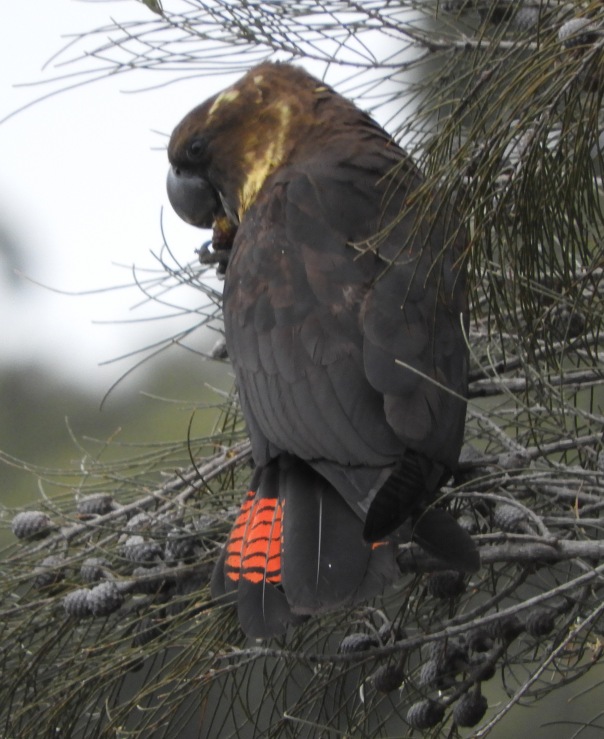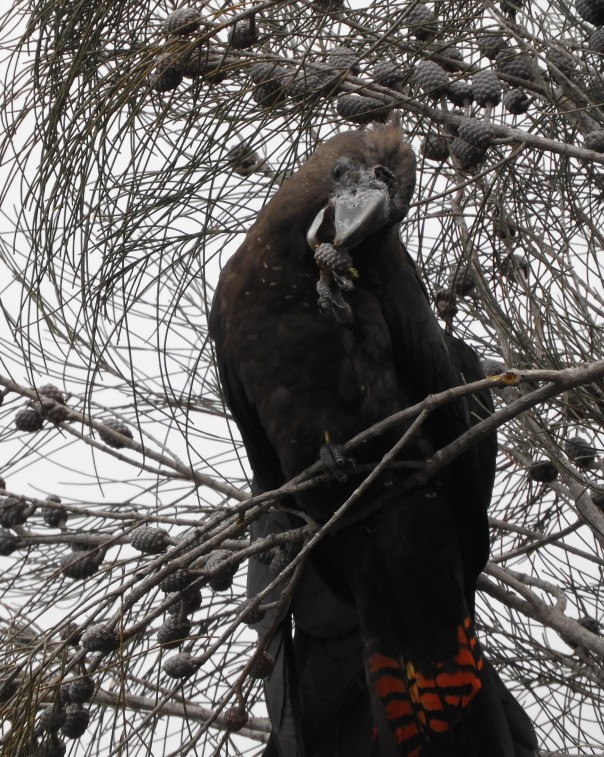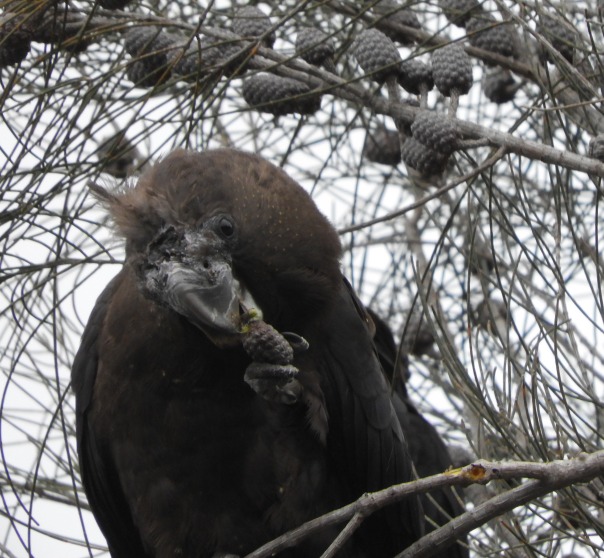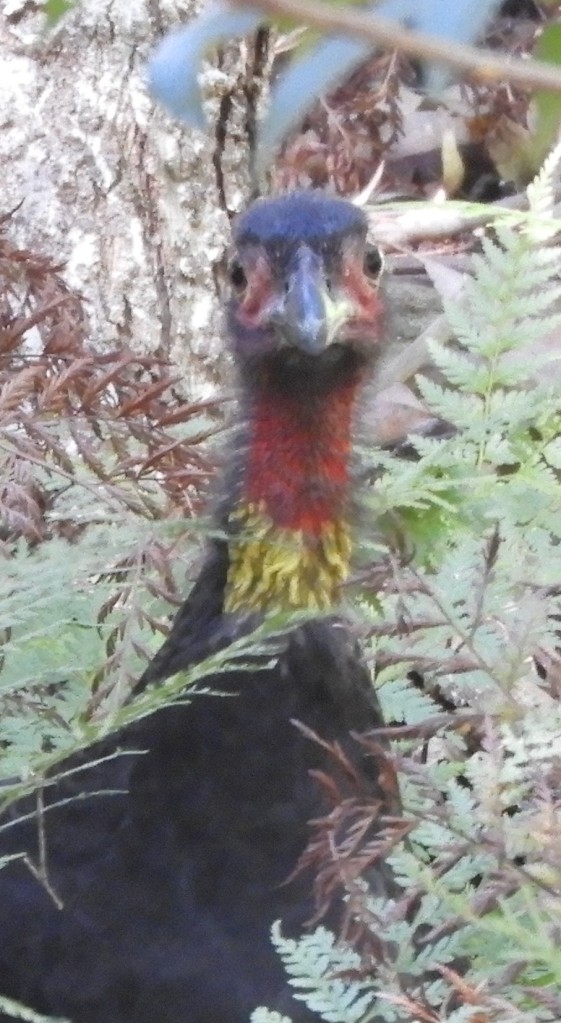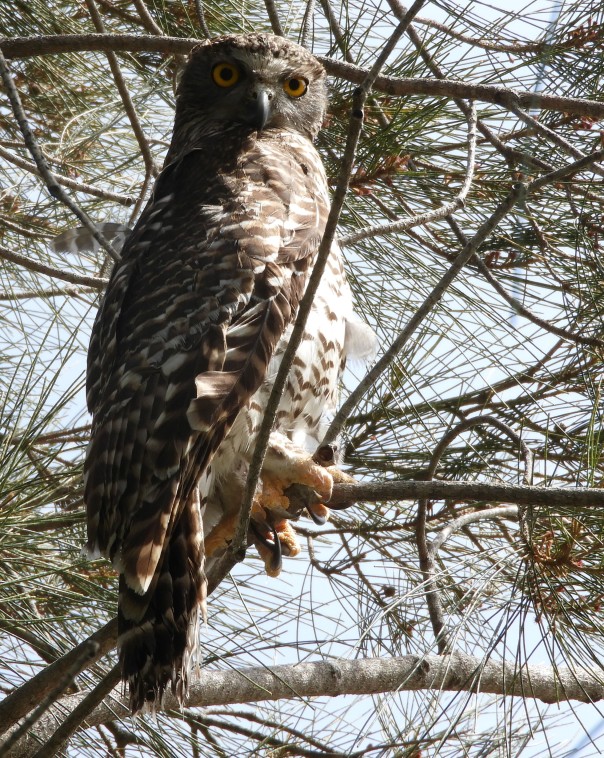Category Archives: Raven
A row of cockatoos and one raven

The arrival of the raven: It’s pouring with rain. Several Sulphur-crested Cockatoos line up on the wall of Manly Dam. Clumping together for company in the dismal weather. An Australian Raven joins the line-up. The cockatoos eye the interloper up and down, but don’t make too much of a fuss. Some of them get bored and head for a nearby tree:
Off camera: A runner arrives and the rest of the cockatoos depart for the tree. The raven doesn’t budge. Another raven arrives.
The return of the cockatoos: They need to reclaim their perch! The strategy seems to be simply to pile into the line-up until it becomes too uncomfortable for the ravens. One raven departs quickly, the other sticks it out for a while, then decides to retreat to a higher roost and gaze down at the silly, squawking cockatoos:
Common name: Sulphur-crested Cockatoo
Scientific name: Cacatua galerita
Approximate length: 50 cm
Common name: Australian Raven
Scientific name: Corvus coronoides
Approximate length: 50 cm
Date spotted: 28 March 2025 (autumn)
Location: Manly Dam, New South Wales, Australia: 33°46’55.3″S 151°15’20.1″E
Osprey chased off by raven and noisy miners
At Long Reef Headland today, an Eastern Osprey sat peacefully on a branch. Then an Australian Raven dived at the osprey, cawing and moaning. The resident Noisy Miners heard the fracas and joined in. After a few seconds, the Osprey decided enough was enough and took off to find a quieter spot.
Eastern Ospreys are magnificent birds. They measure up to 65 centimetres from head to tail, and have a wingspan of up to 1.7 metres. They eat fish, which they catch by diving into the water from a height and dragging the fish out of the water in their claws.
We first spotted this osprey perched on the edge of a cliff. Later, we saw it a few metres further on, in a tree high on a ledge above the beach.
Here’s the osprey enjoying the sun and the view, before the other birds arrive:
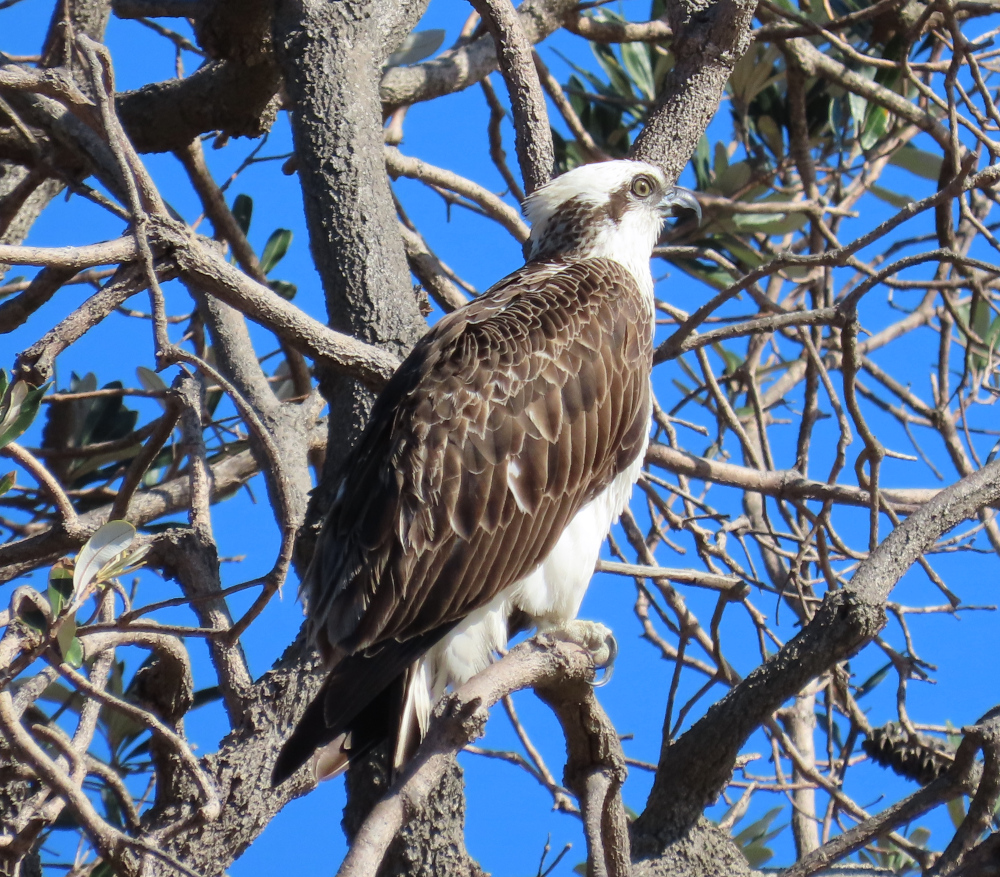
Then the Australian Raven arrived. Here the Osprey is warning the raven off:

That’s when I started the video recording, which you can watch at the top of this post.
Here’s the best picture I have of the osprey in flight:

Common name: Eastern Osprey
Scientific name: Pandion cristatus
Approximate length: 57 cm
Date spotted: 19 June 2024 (winter)
Location: Long Reef Aquatic Reserve, Collaroy, New South Wales, Australia: 33°44’19.7″S 151°18’42.0″E
Birds galore at Long Reef Aquatic Reserve, Collaroy
Last week I spent a couple of hours at Long Reef Aquatic Reserve in Collaroy, NSW. I was there just for a walk with my partner, but I was delighted at the number and variety of birds we encountered.
First up were two raptors, a real treat to see. A Black-shouldered Kite (Elanus axillarus) hovered in the air, effortlessly riding the currents and looking out for prey:
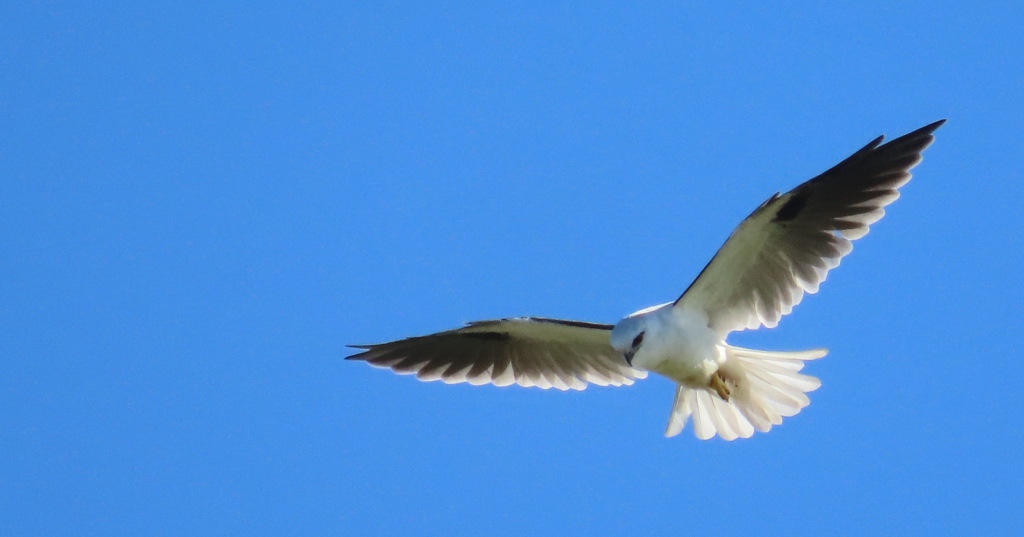
An Eastern Osprey (Pandion cristatus) soared in circles, grasping a half-eaten fish in its feet:
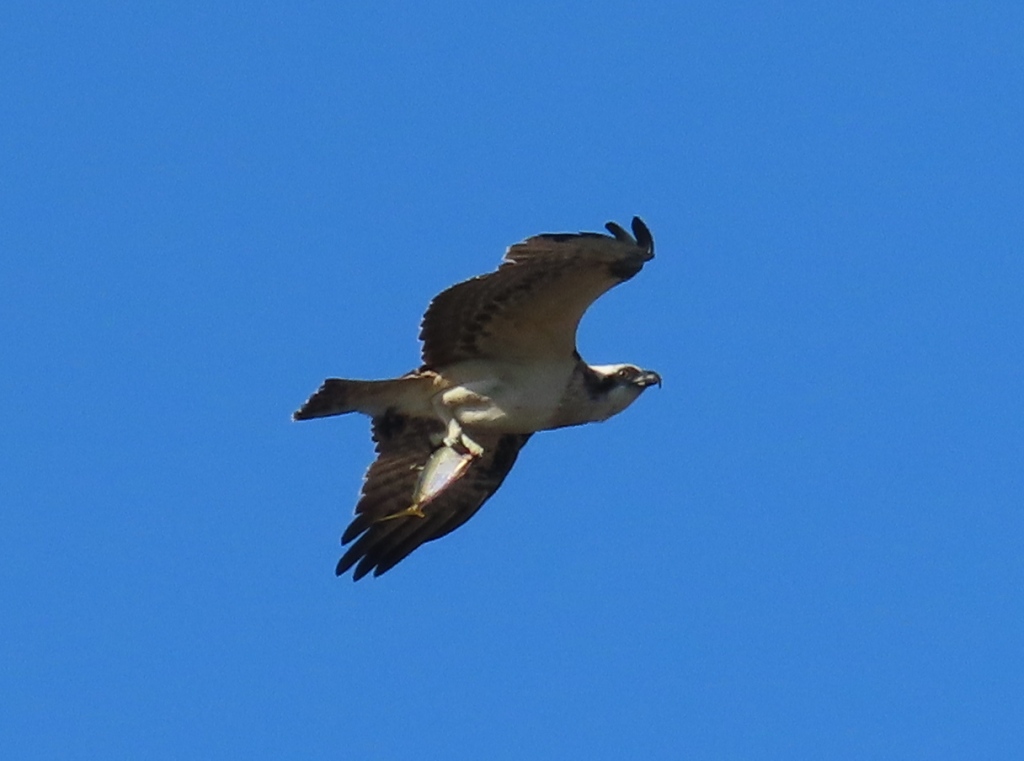
I’ve written a separate post about these two birds, a third raptor, and some paragliders who shared the air currents with the kite: Three raptors in one day.
Huge Pelicans (Pelecanus conspicillatus) perched on the lampposts and glided above my head. Here’s one of them, looking sad and wise:
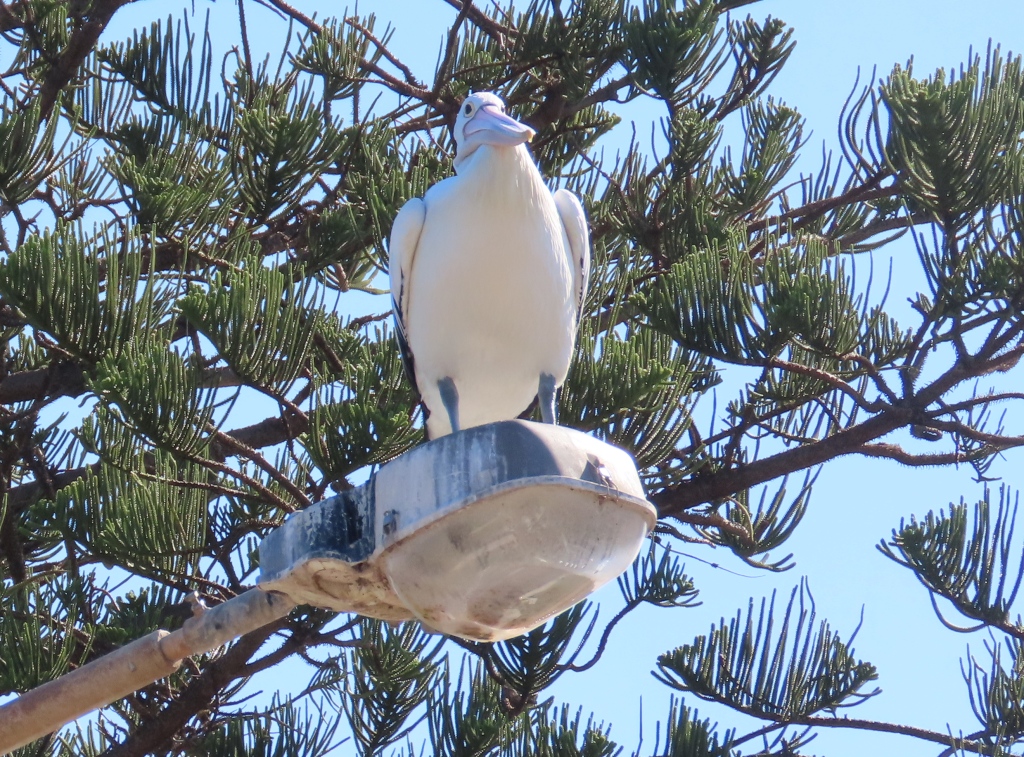
Another post has more pictures of these magnificent birds: Three pelicans on a lamppost.
A female Darter (Anhinga melanogaster) sat on a metal structure above the beach, surveying all the action with a cautious eye:

Silver Gulls (Larus novaehollandiae) wheeled around the fishermen at the edge of the rock plate:

Australian Ravens (Corvus coronoides) picked through the stranded seaweed in search of a snack:

Here’s a close-up of one of the ravens:
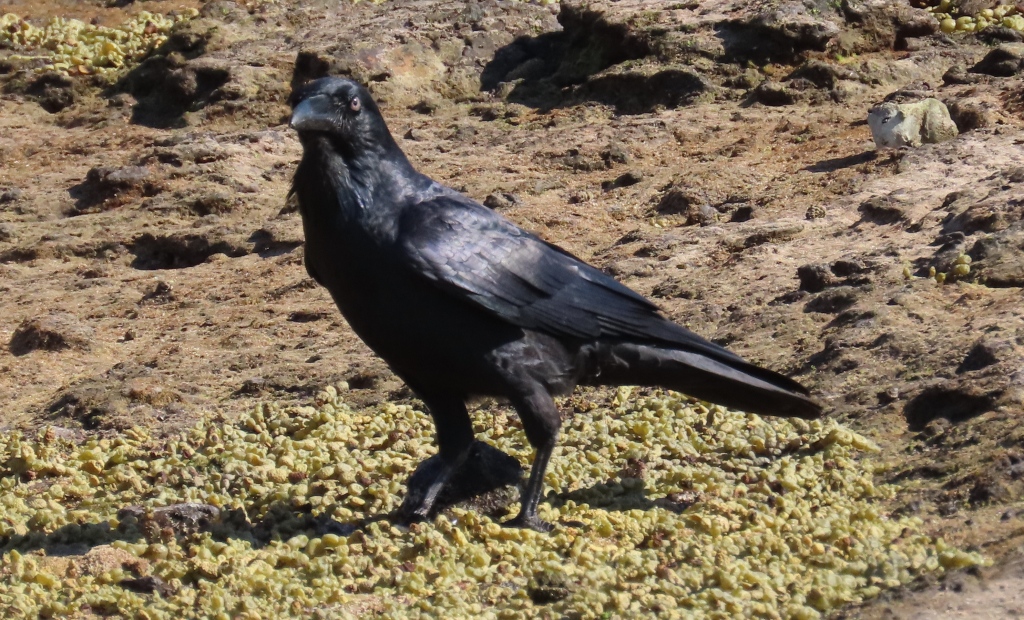
Fish skulked in a nearby rock pool:

A crab came out from under a rock, ready to dash back in at the slightest sign of danger:

A White-faced Heron (Ardea novaehollandiae) patrolled the border between land and sea:
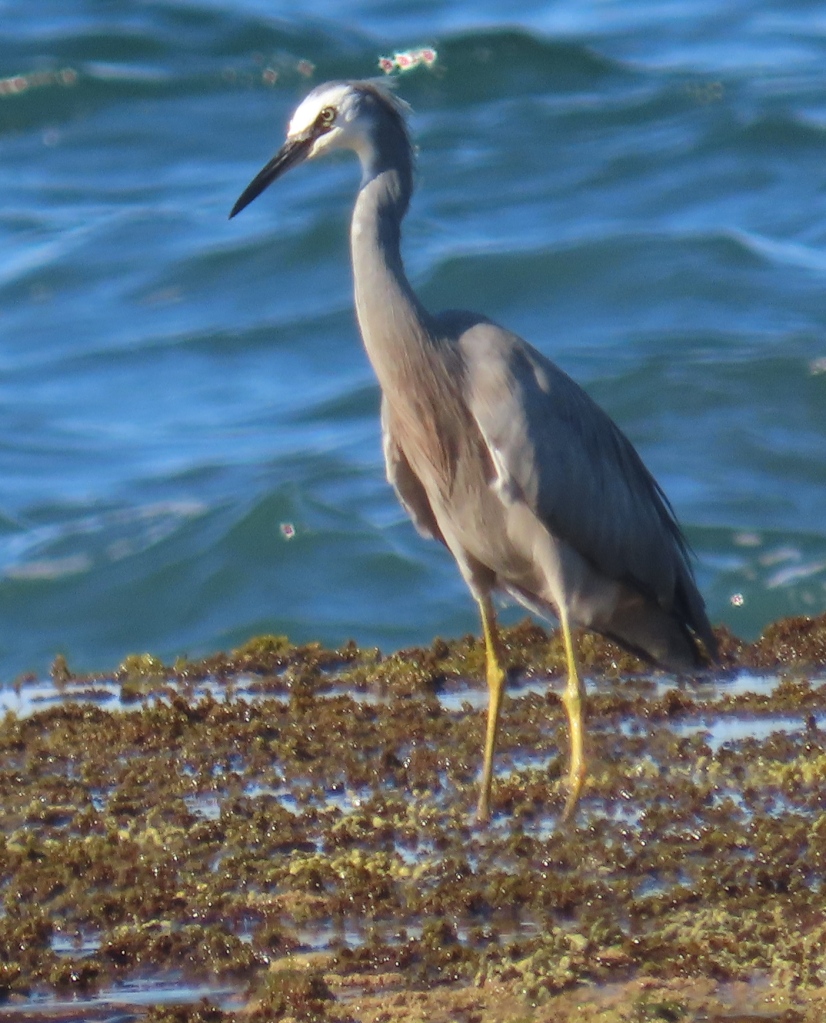
On the grassy headland above the beach, a Magpie-lark (Grallina cyanoleuca) owned the land. These birds are also called Peewees, because of the loud shrill call (peeee-wheee) that they make whenever a person or anything else comes too close:
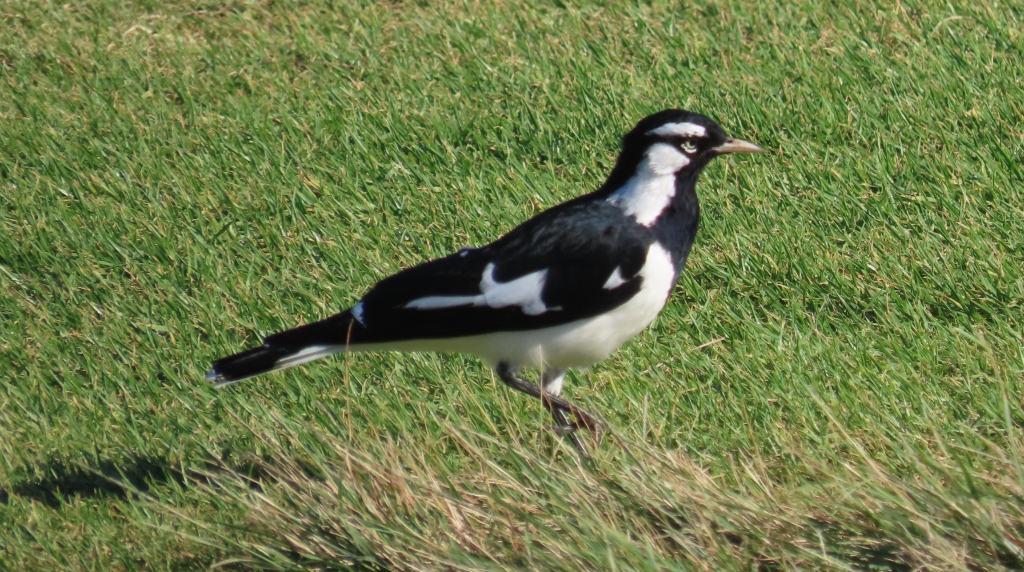
To close off with, here are a couple of shots showing the colours and serenity of the Long Reef Aquatic Reserve that afternoon. First, looking from the rock plate towards the land:
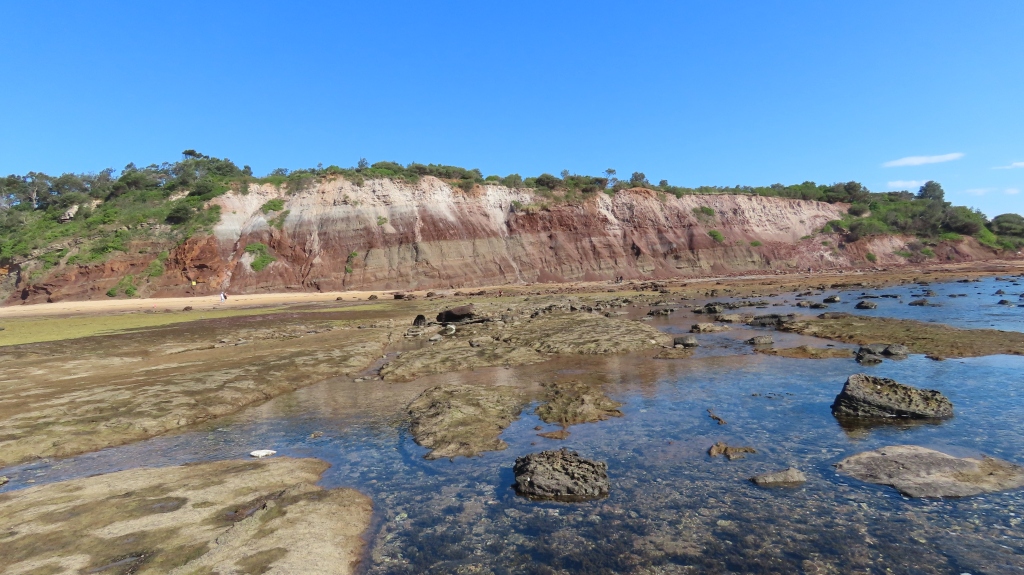
Then looking out to sea:

Post-fire scenes from the Australian bush
The National Parks and Wildlife Service recently conducted a hazard reduction burn in one of my favourite bush-walking areas. The NPWS lights these controlled fires to burn away excess vegetation, which reduces the chance of a more severe fire raging out of control during fire season.
Many of the plants in the Australian bush are adapted to cope with fires. For example, these Hakea seedpods popped open after the fire, allowing the seeds to escape:
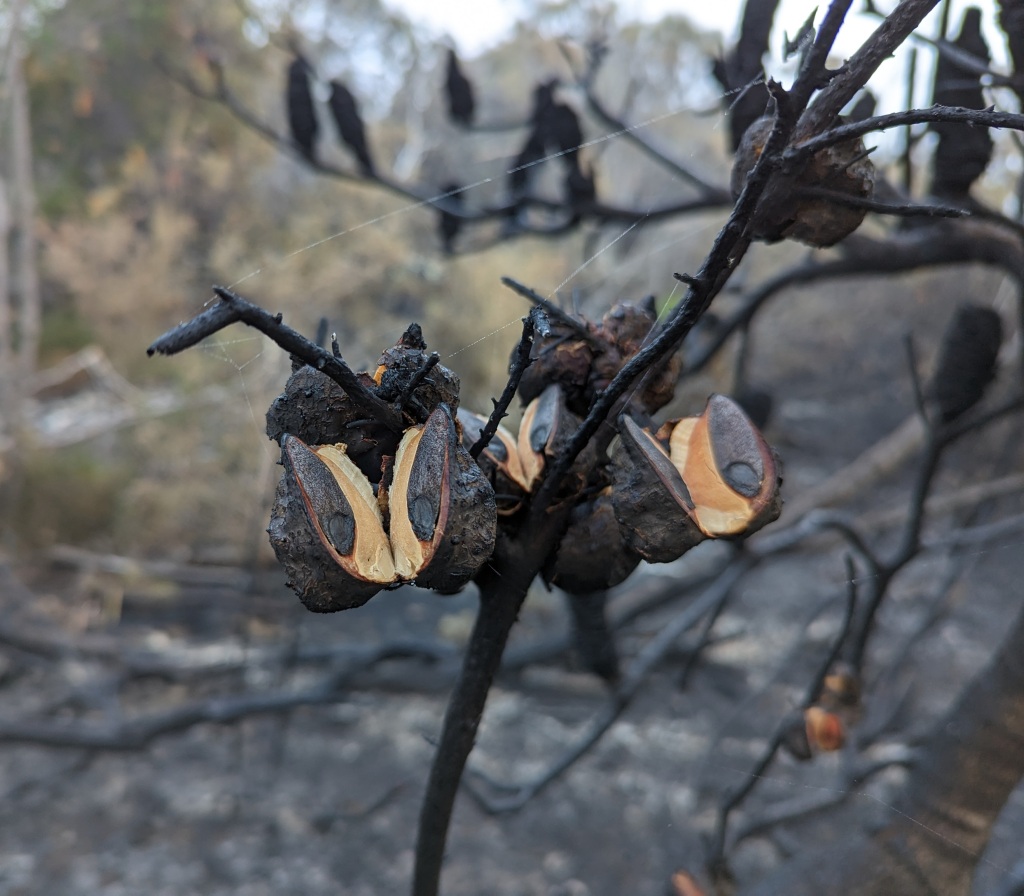
The above seed pods have both seeds still in place — the seeds are black and oval-shaped. Each seed is attached to a thin membrane, which acts as a wing: when the seed is released, it spirals gently to the ground. If there’s any wind around, the seed can travel a short distance from its parent bush.
In the next photo, only one of the seeds remains in the pod:

The next photo shows the seed head of a Banksia bush, also popped open to release the seeds. The open pods look like smiling mouths:

An Australian Brush-turkey wanders over the ashes, looking for pickings. A discarded can echoes the bird’s colouring:
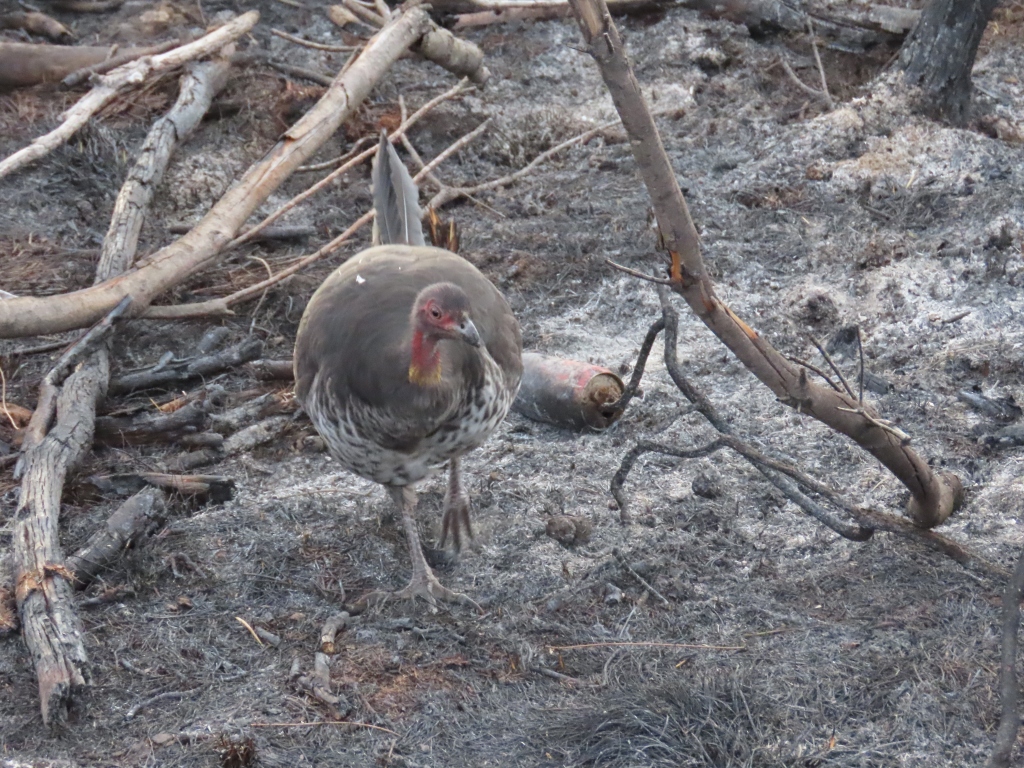
Nearby, Australian Ravens look for insects and other goodies:

A Currawong keeps a watchful eye over the proceedings:

A Rainbow Lorikeet adds a splash of colour, hoping to snag a Casuarina seed or two:
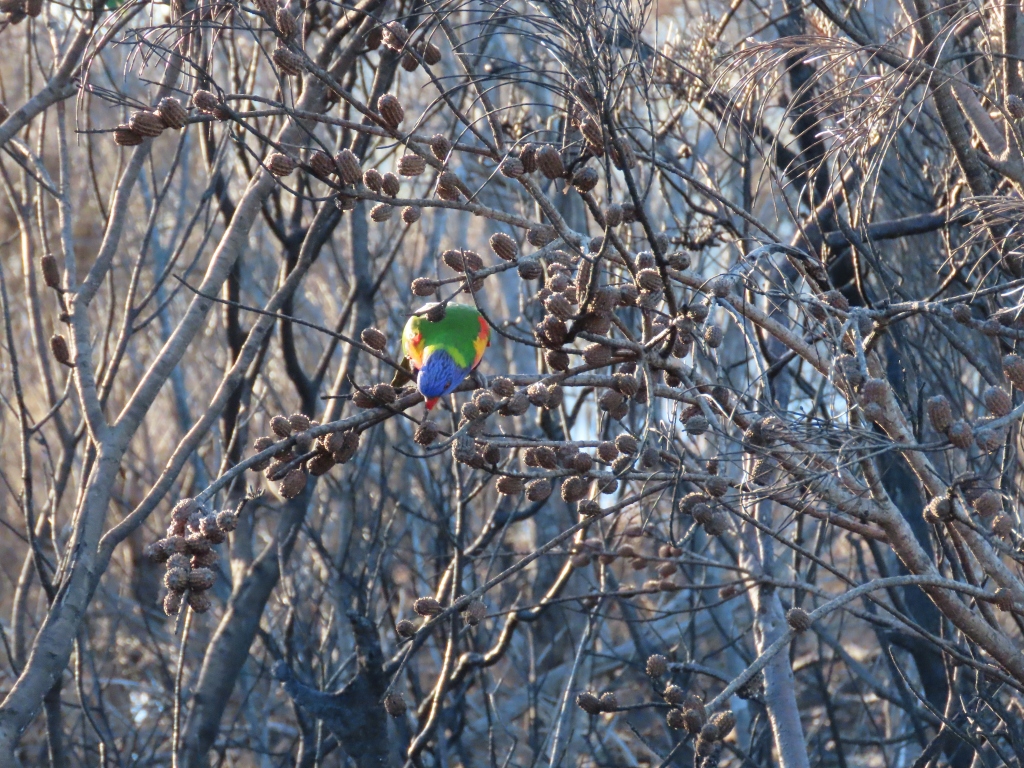
It’s much easier to grab a seed now that the fire has dried out the seedpods!
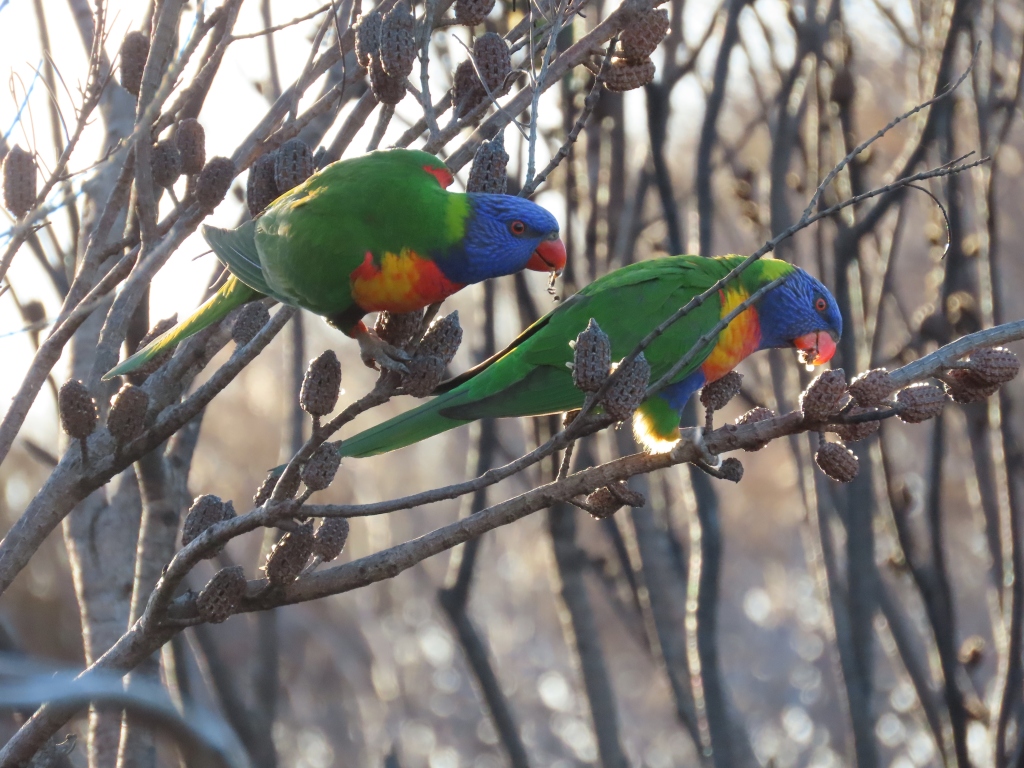
A week later, a Swamp Wallaby shared the browns and greys of the burned area too:
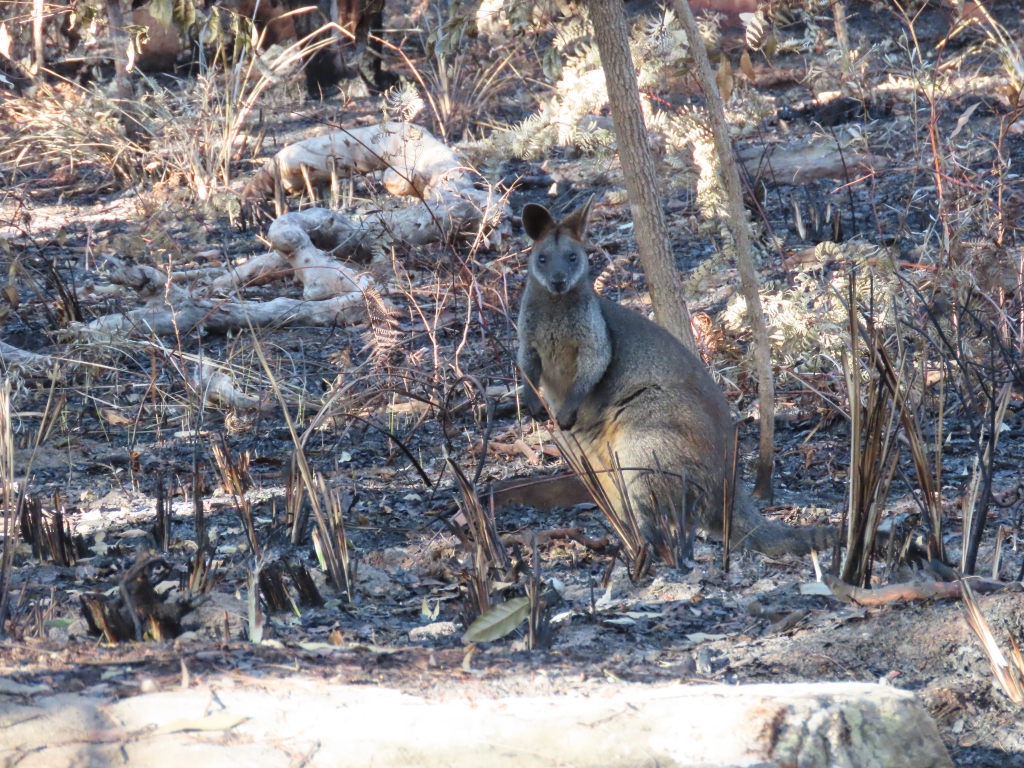
Here’s a video of the wallaby. At one stage, a plane flies overhead and a group of birds squawk loudly. The wallaby looks at me, checking whether I’m the cause of the disturbance, then goes calmly about its business:
To close, here’s a restful scene of the post-fire forest in the early morning light:

Date spotted: Early June, 2023
Location: Dobroyd Head, Sydney Harbour, NSW, Australia; between this point and this point on the map.
Territory! Ravens vs Lorikeets
The National Parks and Wildlife Service recently did a hazard reduction burn in the area where I often go for a walk. This morning, a group of Rainbow Lorikeets occupied some bare branches with a strategic view of the newly cleared area. Right next door, a collection of ravens had the same idea. They viewed each other for a while, then all hell broke loose.
Turn up the volume to get the full effect! Listen to the bawling ravens and the scolding parrots. When things really get hectic, hear the whop-whop-whop of wings swooping overhead.
Here’s a closeup of some of the ravens, in their best villain pose:
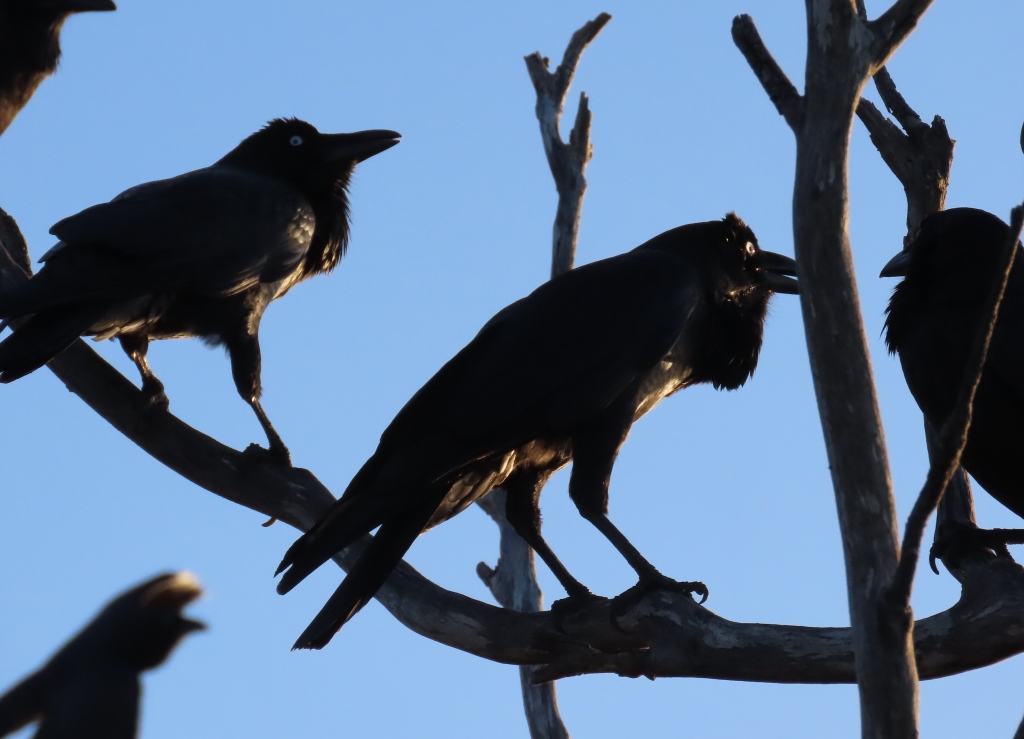
Common name: Australian Raven
Scientific name: Corvus coronoides
Approximate length: 50 cm
Date spotted: 10 June 2023 (winter)
Location: Dobroyd Head, New South Wales, Australia: 33°48’36.6″S 151°16’23.9″E
And the I’m-so-pretty, butter-wouldn’t-melt-in-my-mouth pose of the lorikeets:
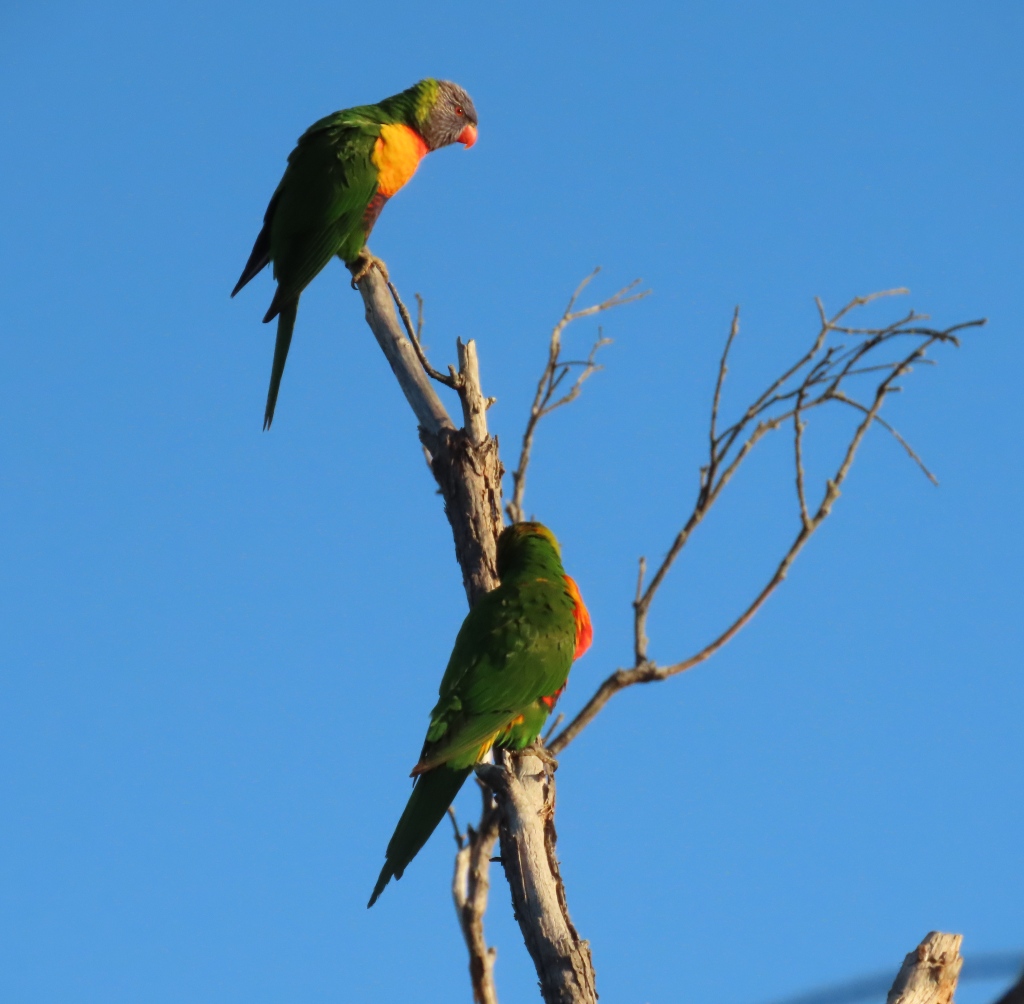
Common name: Rainbow Lorikeet
Scientific name: Trichoglossus haematodus
Approximate length: 30 cm
Date spotted: 10 June 2023 (winter)
Location: Dobroyd Head, New South Wales, Australia: 33°48’36.6″S 151°16’23.9″E
Laughing Kookaburras with a drop-in Australian Raven
As I was crossing the dam wall at Manly Dam, a couple of Laughing Kookaburras landed on the railing a few metres away and started cackling. I managed to get my camera out in time to recorded some of their song. (That’s unusual, because most kookaburras stop and look at you when you stop and look at them!)
A few seconds into their song, an Australian Raven appeared as if from nowhere and landed on one side of the kookaburras. They seemed annoyed. Then the raven hopped into the air above the kookaburras. It’s funny to see the kookies stretch their necks upwards to keep the raven in view. The raven, ever annoying, then landed on the opposite side of the kookies. At that stage, the kookies decided enough was enough, and flew away.
Laughing Kookaburra (Dacelo novaeguineae) — approximate length: 47 cm
Australian Raven (Corvus coronoides) — approximate length: 50 cm
Date spotted: 13 August 2022 (winter)
Location: Manly Dam Park, New South Wales, Australia: 33°46’53.9″S 151°15’20.2″E
3 Glossy Black-Cockatoos and a tale of a Brush-turkey and a Raven
Two days ago, I encountered a group of three Glossy Black-Cockatoos on a Casuarina tree. These large cockatoos are not a very common sight. When I noticed them, I stopped walking and said “ooh” out loud. Luckily there was no-one around to hear, and the birds ignored me!
While I was watching the cockatoos, a couple of other characters appeared and contributed to the encounter. Read the story below!
First, the glossies
This picture shows two of the Glossy Black-Cockatoos. They’re quite different in appearance from the more common Yellow-tailed Black-Cockatoos. The feather arrangement around the glossies’ necks and the general setting of their heads make me think of a lion:
I think the bird on the left is a female, as she has a lot of yellow around her head. The one on the right is, I think, a male.
In the video below, the birds are munching happily on Casuarina seed pods. About half way through the video (at around 50-53 seconds on the timeline) the birds mutter to each other in low-pitched raspy calls. This munching and muttering is typical of the birds’ behaviour.
Below is a solo shot of the first of the three birds. This one has a lot of yellow around its head, which means it’s probably a female:
Glossy Black-Cockatoos depend on Casuarina seeds for their food. This choosiness puts the birds at risk when the tree coverage is depleted by land clearance or bush fires. Casuarinas, also called sheoaks or she-oaks, are a group of trees and shrubs native to Australia and other Asian countries. Evidently the name Casuarina is derived from cassowary (a big bird) because the branches look like cassowary feathers.
Next comes a solo shot of the second of the three birds. I think this one is a male. The feathers around its head and neck are quite brown in comparison to the darker black feathers on the rest of its body. The bird is holding a Casuarina seed pod. You can also see a few of the tree’s tiny red flowers:
It’s a treat to see these unusual, gorgeous birds. Definitely a moment for oohing and aahing.
Unwell Glossy Black-Cockatoo – beak and feather disease?
One of the three cockatoos has an illness which has affected its beak. It may be Psittacine beak and feather disease, or some sort of cancer, or maybe the result of a fight or accident?
I didn’t notice the hole above the bird’s beak until I got the pictures home and put them on a big screen. The birds were quite a distance away, and I was using my camera’s super zoom to photograph them. But even from the long distance, I did think that the bird looked duller and more skeletal than the other two.
Poor bird, I hope the condition isn’t causing it too much discomfort.
Video featuring the female Glossy Black-Cockatoo
Here’s another video of two of the birds, this time featuring the female. Hint: At the start of the video you can hear a bit of thrashing around in the undergrowth. That background noise leads into the story below!
Common name: Glossy Black-Cockatoo
Scientific name: Calyptorhynchus lathami
Approximate length: 50cm
Date spotted: 18 September 2020 (spring)
Location: Manly Dam Park, near Sydney: 33°46’55.0″S 151°15’10.1″E
A tale of a Brush-turkey and an Australian Raven
If you listen carefully in the first half of the above video, you’ll hear a bit of a kerfuffle in the background. I heard it too, and turned to look when I stopped filming. I saw an Australian Brush-turkey flapping around among the trees a few metres away from me. “Ah, just a brush-turkey,” I thought, and turned back to the cockatoos. Brush-turkeys seem to specialize in making a fuss about nothing.
The kerfuffle turned into a whoosh of large wings, followed by a downdraft of air and the sound of claws on metal. I turned around again, to discover that the brush-turkey had landed on a gate less than two metres away from me. (The gate was one of those that the authorities use to close the park when the danger of bush fires is critical.)
“Hallo, mate,” said I. “What are you up to?” I do talk to birds when they approach me, partly to make us both feel comfortable.
The brush-turkey look at me, then teetered slightly and looked down at the ground with some apprehension. They do that, when they’re off the ground. They’re no doubt thinking, “I got myself up here, but now that ground is a long way down. How do I get down there?”
Two seconds later, a large, fierce Australian Raven arrived. Eyes ice blue. Beak long, strong, and pointy. Being the focus of that glare is rather daunting, even if you’re a large human.
The raven glared at me. I stood my ground. One point five metres of empty space between me and that beak.
The raven decided I wasn’t a threat, and turned its attention back to the brush-turkey. Obviously, the raven wanted to continue the altercation that had been the cause of all that kerfuffle in the trees.
The brush-turkey looked at the raven, looked at me, and hopped off the gate. A few hurried steps, and it was at my feet. It got as close to my knees as it could, then started walking round my legs. When it comes to a choice between a raven and me, it seems I’m a safe haven.
The raven looked thoroughly peeved. It leapt into the air and spotted the Glossy Black-Cockatoos, who were still peacefully munching and muttering in the Casuarinas. With a caw and a swoop, the raven dislodged the glossies. They floated into the air with easy grace, and came to land again a few trees away. “Ah, ravens,” the glossies were no doubt thinking. “They seem to specialize in making a fuss about nothing.”
The brush-turkey was still jittering around my legs. I wanted to continue filming the cockatoos, so I waited for a gap in the brush-turkey’s circle, and strode out along the path towards the cockatoos’ new roosting area.
Within a second, I heard the tick-tick-tick of brush-turkey claws on the path. The turkey had decided to stay with its safe haven for a while, in case that nasty bird with the ice-blue eyes and big strong beak came back.
So there we were, the cockatoos munching and muttering, I oohing and aahing, and the brush-turkey click-clacking companionably at my heels.
I wish I’d got all of that on camera! Anyway, I hope you enjoyed the story. 🙂
Here are a couple of pics of a brush-turkey and a raven, though these are not the same birds that appear in this story.
Rescued a Powerful Owl from Australian Ravens
As I was walking in the bush this morning, I heard a lot of noise coming from an open space just off the track. Currawongs chiming, ravens yowling, miners bleating. I went to investigate, and found a Powerful Owl under attack.
Here’s the Powerful Owl, looking decidedly jaded after facing off the most recent jabs from a couple of Australian Ravens:
The Australian Miners and Currawongs were making a lot of noise, and even a couple of kookaburras swooped in to join the fight. But the principal attackers were the Australian Ravens.
At first, the Powerful Owl was able to fend off the attack:
But the ravens were pretty vicious. The owl was high in the tree at this point, and there was nothing I could do to scare off the attackers.
I phoned the Manly Dam bush ranger centre and reported the problem. A ranger promised to come immediately. In the meantime, the owl was suffering and it was distressing not to be able to help:
At last, the owl ceded ground and flew to a lower spot in the tree:
At the same time, the attacks became more vicious, with the ravens grabbing both wings and pulling at the same time, stretching out the owl’s wings.
The owl was at this point only about 2.5 metres above the ground. A jogger came rushing in to help, and together she and I were able to scare off the ravens and other attackers.
The bush ranger arrived soon afterwards. After a bit of discussion, we decided the best thing was to phone WIRES for advice. WIRES is the Australian Wildlife Information, Rescue and Education Service.
In the meantime, we had to keep chasing away the ravens. They were extremely persistent, returning every few minutes to see if the coast was clear for another attack. The owl looked on, more relaxed than when under attack, but still alert:
Common name: Powerful Owl
Scientific name: Ninox strenua
Approximate length: 65 cm
Date spotted: 7 October 2019 (spring)
Location: Manly Dam National Park, New South Wales, Australia: 33°46’55.8″S 151°15’12.1″E
The advice from WIRES was to leave the owl where it was (don’t try to scare it into flying away) and to keep chasing away the ravens. Evidently Powerful Owls tend to stay in one place during the day, even when under attack. Besides which, the jogger had seen the owl flying from one tree to another earlier that morning, with the ravens dive-bombing it in flight. So flying off was probably not a good option anyway.
So we kept chasing away the ravens. After a couple of hours, two families arrived and settled in for a day of boating and picnicking. We handed over the job of raven-scaring to them, and the bush ranger said she would drop by every couple of hours to check up on the owl.
Not a restful day for this nocturnal bird. But at least this is one case where it was a good thing for the bird that people were around. I do hope the Powerful Owl had a more peaceful time for the rest of the day.
Australian Ravens building a nest and crooning
Nesting is a tricky business. If you’re an Australian Raven, there’s a lot of moaning involved. I heard the fuss while walking along a bush path, and peered up high into the trees to see what all the commotion was about. This video starts with the two ravens weaving twigs into their nest. The nest looks more like an untidy platform of sticks at this stage. The birds croon to each other throughout the process. One of the birds flies off. It lands close to me, grabs a stick, and makes a bit of a fuss about getting just the right grip before taking off for the nest:
Australian Ravens are large birds, with ice blue eyes, black plumage that shimmers blue in the sun, and a thick ruff of feathers under their beaks. When they’re flying, they make a long drawn-out cawing that can sound like a wailing cat.
The next video shows more of the nest building and crooning. At first one raven is alone in the nest, and takes time out to have a bit of a stretch. Then its partner arrives, and the serious business of nest building starts again. It’s funny how the birds’ voices wobble when they bob their heads up and down, trying to get those pesky sticks into the right position:
Common name: Australian Raven
Scientific name: Corvus coronoides
Approximate length: 50 cm
Date spotted: 24 August 2019 ( Late winter)
Location: Manly Dam Reserve, New South Wales, Australia: 33°46’59.7″S 151°15’14.8″E
Flying with a forked twig is tricky, thinks this Australian Raven
Flying with a forked twig must be tricky. Especially if you’re flying through a forest of gum trees.
It’s early spring, and some birds have started building nests. I watched this Australian Raven and its partner pick up twigs and carry them away to their nest high in the trees. Then one of the birds found two perfect twigs. The only problem was that the twigs were attached together.
Hmm, let’s see. I could snip off one half with this great big beak of mine. Nup, that didn’t work.
Maybe if I hold it this way… Nup, tree-entanglement potential too high.
If I stand on one half, the other half should break off. Nup, too green.
OK, this is just taking too long. Plus, it’s annoying.
Grab it in the middle. I’m off.
Common name: Australian Raven
Scientific name: Corvus coronoides
Approximate length: 50 cm
Date spotted: 3 August 2019
Season: Winter
Location: Manly Dam Reserve, New South Wales, Australia: 33°46’15.6″S 151°14’48.9″E





